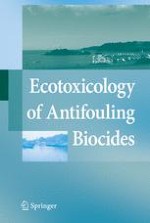2009 | OriginalPaper | Buchkapitel
Organotin Contamination in Deep Sea Environments
verfasst von : Hiroya Harino, Takaomi Arai, Madoka Ohji, Nobuyuki Miyazaki
Erschienen in: Ecotoxicology of Antifouling Biocides
Verlag: Springer Japan
Aktivieren Sie unsere intelligente Suche, um passende Fachinhalte oder Patente zu finden.
Wählen Sie Textabschnitte aus um mit Künstlicher Intelligenz passenden Patente zu finden. powered by
Markieren Sie Textabschnitte, um KI-gestützt weitere passende Inhalte zu finden. powered by
Deep sea environments are divided into the bathyal zone (200–2,000 m), the abyssal (2,000–6,000 m) and the hadal zone (over 6,000 m). These zones cover the largest part of the ocean biome (more than 80%). Until now, it was considered that these zones were deserts because sunlight could not reach to such depths and pressures were too high for biota. Advances in deep sea submersibles and image capturing technologies are now increasing the opportunities for marine biologists to observe and uncover the mysteries of the deep ocean realm. Remotely operated vehicles (ROVs) have been used underwater since the 1950s. ROVs are basically unmanned submarine robots with umbilical cables used to transmit data between the vehicle and researcher for remote operation in areas where diving is constrained by physical hazards. ROVs are often fitted with video, cameras, mechanical tools for specimen retrieval and measurements. Subsequently, manned deep sea submersi-bles have been developed and research has progressed. Although the deep sea is in total darkness, is extremely cold, and subjection to great pressure, the marked development of bathyscaphes has revealed the presence of many deep-sea organisms such as bivalves and gastropods in water depths of 3,000 m and more, and has permitted the collection of sediment and marine organisms (e.g. Endo et al. 1999; Okutani et al. 2002; Okutani and Iwasaki 2003).
The contamination of deep-sea ecosystems by man-made chemicals has also been clarified by progress in diving technology. Organochlorine insecticide residues were measured in the livers of
Antimore rostrata
, a deep sea fish collected from 2,500 m in 1972, 1973, and 1974 off the east coast of the United States (Berber and Warlen 1979). Subsequently, metals, polycyclic aromatic hydrocarbons (PAHs), polychlorinated biphenyls (PCBs) and chlorinated pesticides in were determined in tilefish (
Lopholatilus chamaeleonticeps
) collected from Lydonia Canyon (on the Georges Bank) in 1981–1982 (Steimle et al. 1990). Persistent orga-nochlorines such as PCBs, DDT and its metabolites (DDTs), chlordane compounds (CHLs), and hexachlorobenzene (HCH) were detected in deep-sea organisms from a water depth of 180–980 m in Suruga Bay (Lee et al. 1997), whilst PCBs have also been detected (22 mg kg
−1
) along with DDTs (13 mg kg
−1
) in amphipods collected from a water depth of 2,075 m in the Arctic Ocean (Hargrave et al. 1992). More recently, detection of persistent organic pollutants has been reported in many kind of samples from various water depths (e.g., Takahashi et al. 1997a). It has thus been concluded that persistent organic pollutants (POPs) and various other contaminants can be transferred to deep-sea areas where they may be accumulated by deep-sea organisms.
